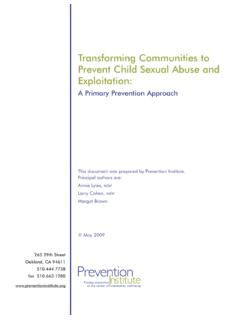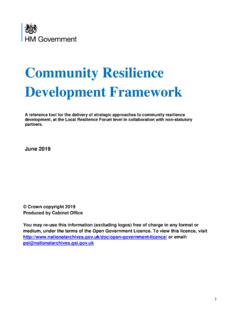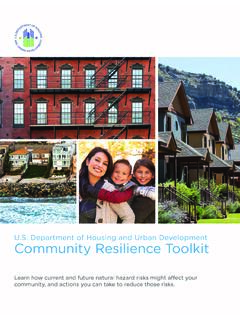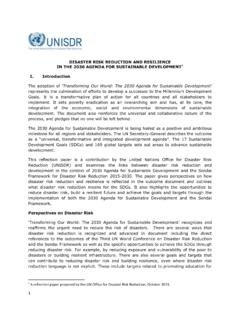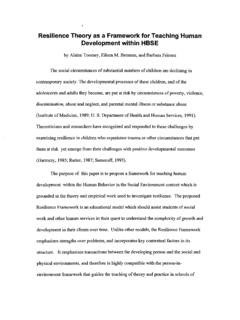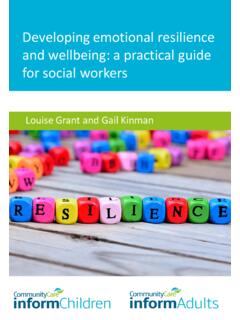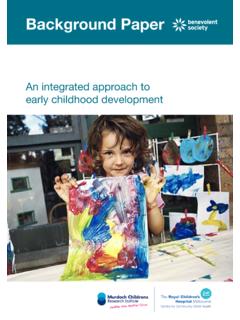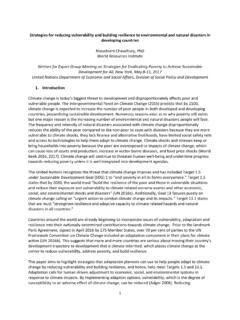Transcription of Adverse Community Experiences and Resilience
1 This paper was supported by a grant from Kaiser Permanente Northern California Community Benefit ProgramAdverse Community Experiences and ResilienceA framework FOR ADDRESSING AND PREVENTING Community TRAUMAC ontentsFunding and Authorship ..1 Acknowledgements ..2 Executive Summary ..3 Introduction: The Need for Understanding Trauma at a Community Level ..7 Themes and Findings ..9A. There is growing understanding about trauma, particularly its prevalence and impact . The predominant approach to dealing with trauma is screening and treatment, consistent with a medical model ..9 1. Trauma is pervasive ..9 2. Trauma has a significant impact on development, health, and well-being ..9 3. Concepts of poly-victimization, complex trauma are changing research on multiple exposures to violence, trauma ..10 4. Trauma-informed care is becoming a standard of care ..10 5. The main construct for addressing individual trauma is based on a medical model ..10B. Trauma manifests at the Community level.
2 There are emerging practices to address trauma at the Community level, yet there is not a framework for addressing and preventing it ..11 6. In high-violence neighborhoods, it s widely believed that whole communities are traumatized ..11 7. Recently, there has been a slight shift toward understanding trauma as collective ..11 8. The predominant focus for addressing trauma remains at the individual level ..12 9. Trauma is a barrier to effective solutions to promote health, safety, and well-being ..12 10. Community trauma symptoms are in the social-cultural, physical/built, and economic environments ..13 11. Emerging practices address Community trauma, including indigenous-based healing and restorative justice ..17 12. No current framework defines Community trauma and identifies its symptoms, which is needed ..18 13. There is an uneven level of capacity to conceptualize and address Community trauma ..19 The Production of Trauma from Violence ..20 Towards a framework for Community Trauma and How to Address and Prevent It.
3 22 Fostering Resilient, Thriving Communities ..26 Promoting Community Resilience : From Trauma to Well-being ..28 Conclusion: It s Time to Take on Adverse Community Conditions ..30 References ..33 Figure 1 The Community Environment ..13 Figure 2 The Production of Trauma from Violence ..21 Figure 3 Community Strategies to Address Community Trauma ..23 Figure 4 Elements of a Resilient Community ..26 Figure 5 Promoting Community Resilience : From Trauma to Well-being ..29 Cover photo provided by Richmond Main Street Initiative1 Adverse Community Experiences and ResilienceFunding and AuthorshipThis paper was made possible by a grant to Prevention Institute from Kaiser Permanente Northern California Community Benefit Program . Principal AuthorsHoward Pinderhughes, Rachel A. Davis, Myesha Williams, Institute is a nonprofit, national center dedicated to improving Community health and well-being by building momentum for effective primary prevention . Primary prevention means taking action to build Resilience and to prevent problems before they occur.
4 The Institute s work is characterized by a strong commitment to Community participation and promotion of equitable health outcomes among all social and economic groups . Since its founding in 1997, the organization has focused on Community prevention, injury and violence prevention, health equity, healthy eating and active living, positive youth development, health system transformation and mental health and well-being . For more information, visit .Howard Pinderhughes is an Associate Professor in the School of Nursing at UC San Francisco . His focus areas include sociological theory; youth violence and adolescent health; race, ethnicity, and health inequality; and social change . The author of Race in the Hood: Conflict and Violence Among Urban Youth, Pinderhughes has examined the dynamics of racial violence . In Dealing With Danger: How Inner City Youth Cope with the Violence that Surrounds Them (forthcoming) he examines the production of youth violence and how urban adolescents think about and experience violence and trauma.
5 Additionally, Pinderhughes was Co-Principal Investigator for the Center on Culture, Immigration and Youth Violence Prevention, one of the Centers for Disease Control and Prevention s Academic Centers of Excellence in Youth Violence Prevention . He is on Prevention Institute s UNITY team, working with US cities to prevent violence .Kaiser Permanente is recognized as one of America s leading healthcare providers and not-for-profit health plans . Recognizing its unique role as both a healthcare provider and Community partner Kaiser Permanente provides funding and clinical expertise to work side-by-side with other organizations to address serious public health issues such as violence and obesity . Through its Adverse Childhood Experiences (ACE) Study, conducted with the Centers for Disease Control and Prevention, Kaiser Permanente demonstrated the connection between violence related trauma and the long-term health of individuals . Through its Healthy Eating Active Living (HEAL) investments the organization promotes Community healing with support for individuals, families and safe public spaces.
6 In 2014, Kaiser Permanente provided more than $18 million to build healthy, safe environments in northern California alone . For more information visit .Pinderhughes H, Davis R, Williams M . (2015) . Adverse Community Experiences and Resilience : A framework for Addressing and Preventing Community Trauma. Prevention Institute, Oakland CA .2 Adverse Community Experiences and ResilienceAcknowledgementsPrevention Institute is grateful to Kaiser Permanente Northern California Community Benefit Program for supporting the development of this paper . We particularly want to thank Jodi Ravel, Senior Manager, Regional Community Benefit Programs for her support and contributions to the development of this paper . We are also grateful to the many members of the UNITY City Network who have shared their Experiences of working in high-violence communities with us and with each other, which has informed the development of this body of work . Finally, we thank the following people from the Northern California cities of San Francisco, Oakland, Richmond, Vallejo, South Sacramento, Stockton and Fresno who shaped our understanding of the current landscape through interviews.
7 Ellen Brown former Community Benefit Manager for South Sacramento, Kaiser PermanenteKanwarpal Dhaliwal Director of Community Health and Integrative Practice, RYSEPaul Flores Manager, Latino Men and Boys at the UNITY CouncilKrista Girty Director, Huckleberry Youth Health CenterChristina Goette Director, Shape Up SFJim Illig Community Benefit Manager for San Francisco, Kaiser PermanenteGreg King Founder and CEO, Always KnockingMargo Levi Clinical Director, Huckleberry Youth Health CenterDeAngelo Mack SVIP Program Coordinator, Wellspace HealthTariq Mohammad Organizer, Families and Fathers of San JoaquinSusan Neufeld Vice President Resident Programs and Services, Bridge HousingSamuel Nunez Executive Director, Families and Fathers of San JoaquinMarie Sanchez Community Benefit Manager for Modesto, Stockton, San Joaquin County and Stanislaus, Kaiser PermanenteKevin Sharps Executive Director, Fighting Back PartnershipKyndra Simmons Program Manager, Caught in the CrossfireIvonne Der Torosian former Community Benefit/ Community Health Manager for Fresno, Kaiser PermanenteCynthia Verrett Community Benefit Manager for Napa-Solano, Kaiser Permanente3 Adverse Community Experiences and Resilience EXECUTIVE SUMMARYI ntroductionMany communities are working to prevent violence and promote Community safety and, through comprehensive, multi-sector actions, are making progress.
8 However, communities that experience high rates of violence continue to be plagued with persistently high rates of trauma . Trauma and its associated symptoms of mental and psychological illness are more prevalent in the U .S . than in most other countries in the world . What s more, trauma can be a barrier to the most successful implementation of healing and well-being strategies, including those to prevent violence .The impact of trauma extends beyond the individuals who directly witness or experience violence . Trauma is also produced by structural violence, which prevents people and communities from meeting their basic needs . The result is both high levels of trauma across the population and a breakdown of social networks, social relationships and positive social norms across the Community all of which could otherwise be protective against violence and other health outcomes . While new models are emerging to counter the effects of trauma, promote Community healing and foster Community Resilience , there has not been an existing framework for understanding, addressing and preventing trauma at a Community or population level.
9 Our paper provides one .EXECUTIVE SUMMARY A framework for Addressing and Preventing Community Trauma4 Adverse Community Experiences and Resilience EXECUTIVE SUMMARYThe Landscape of TraumaA There is growing understanding that trauma is widespread and has far-reaching impacts. The predominant approach to dealing with trauma is screening and treatment, consistent with a medical model. Trauma is pervasive . Trauma has a significant impact on development, health and well-being . Trauma-informed care is becoming a standard practice in a growing number of places . The predominant construct for addressing individual trauma is based on a medical model .B Trauma manifests at the Community level. There are emerging practices to address trauma at the Community level, but there is not yet a framework for addressing and preventing it. In communities with high levels of violence, the idea that whole communities are traumatized is a widespread belief . In recent years, there has been a slight shift from understanding trauma solely at the individual level to also include collective trauma.
10 Despite the increasing recognition of the widespread nature of trauma as an epidemic at the population level, the predominant focus for addressing trauma remains at the individual level . Policy makers, public health officials, social services providers and Community organizers report that trauma undermines efforts to promote health, safety and well-being . There are manifestations, or symptoms, of Community trauma at the Community level . The symptoms are present in the social-cultural environment, the physical/built environment and the economic environment . The social-cultural environment: The economic and social processes that concentrate poverty and urban decay in inner city neighborhoods damage social networks and trust, the ability to take action for change, and social norms . The physical/built environment: Economic and social changes in the last 50 years have led to communities where high rates of poverty are concentrated in neighborhoods with crumbling infrastructure: There are dilapidated buildings and deteriorating roads, poor transportation services and crippled local economies.


